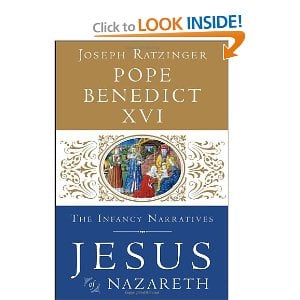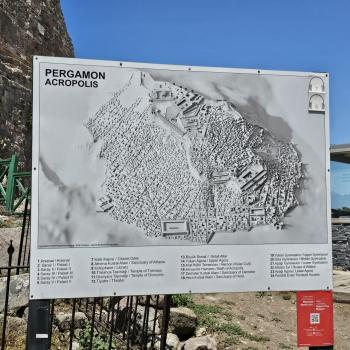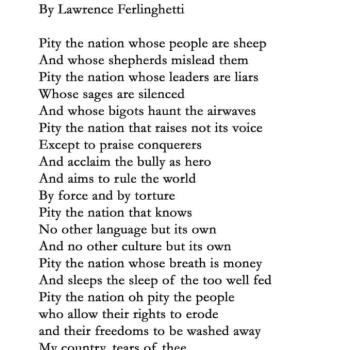Of late we have heard in the news about a discovery of a town near Nazareth called Bethlehem, and not unexpectedly, some archaeologists are suggesting that this is more likely to be the birthplace of Jesus, than the ‘city of David’. Whatever the merits of this view, it is not what either the Lukan or Matthean birth narratives say or suggest, and the reference to Bethlehem as the birth place is one of the most salient facts that Mt.1-2 and Lk. 1-2 share in common.
The third chapter of the Pope’s book begins with an interesting comparison of the Priene inscription lauding Augustus and the good tidings of the birthday of this god who would bring peace and salvation to the world, and the Lukan census story. The Pope knows well about the problem in regard to the date of the census of Quirinius which most scholars think transpired in about 6 A.D. well after the birth of Jesus (in about 2-4 B.C.). But the Pope points out that the census leading to new taxes process could be long and drawn out, with the first stage simply involving going to the locale where one had property and registering for the census there. So perhaps, says the Pope, Joseph had property in Bethlehem, and the actual taxation process came later (pp. 62-63). In any event, the Pope sees Luke as playing up the universal aspects of the Augustan reign to suit the parallel with the stress on universalism in the Lukan Gospel— one savior for all the world who is the prince of peace. But there is also a stress on particularity— Luke is stressing the historical character of Jesus’ origins by telling us who was ruling when he was born, and indeed who was ruling when his ministry began, in about 27 A.D. God and salvation history, rather than the Emperor and his plans for taxation, are the real guiding forces in history.
The Pope will have none of the notion that Jesus was born in Nazareth, something none of our sources say or even suggest. He stresses that we have independent witnesses in Matthew and Luke to the fact that he was born in Bethlehem, and he suggests that Matthew may not have known that Joseph and Mary were originally from Nazareth, since they only go there upon their return from Egypt and from learning that Judea is in bad hands (pp. 64-65).
The Pope apparently subscribes to the popular mistranslation of the key verse in Luke— ‘for there was no room for him in the inn’ and yet he draws a parallel with John 1.11 which says he was not received in his own home. It seems clear enough that by Katalumati Luke means guest room, as this is the same word he uses in the last supper story to refer to the guest room. The point is, when Joseph got to the ancestral home, there was no room in the guest room, and so the family put them in the back of the house where the beast of burden would normally be kept. They were not kicked out of a inn or their family home. One could however raise questions about why, whatever relatives were in the guest room, didn’t give it up when they saw a heavily pregnant Mary! The Pope thinks it likely Jesus was born in a stable, perhaps in a cave (pp. 67-68).
The Pope cautions that the term ‘first born’ does not necessarily refer to first in a series of children (p. 70) though it certainly can do so. Interestingly he compares this to Paul calling Jesus the first (re)born of many brothers and sisters in the resurrection (Romans), and even the first born of all creation in Col. 1, which probably just means pre-eminent over all creation. The Pope thinks there is something to the notion that the Micah prophecy (5.1-3) talks of a leader who will shepherd his people, and also refers to the birth in Bethlehem, and here in Luke the shepherds are the first to receive the news of the birth.
On pp. 74-75 the Pope deals with the difficult phrase “and on earth peace, towards men with whom he is pleased”. But who would they be? The shepherds in this story? Interestingly the Pope draws a parallel with 3.22 where it is Jesus with whom God is well pleased, and he suggests the text means persons who share the attitude of the Son.
Again on p. 76 the Pope reflects on divine sovereignty and human freedom, and cautions against translations of the Lukan verse in question that are either too deterministic (peace on those God has chosen to love), or too moralizing (peace on people of good will). He adds “Grace and freedom are thoroughly interwoven, and we cannot unravel their interrelatedness into clear formulae. It remains true that we could not love if we were not first loved by God. God’s grace always precedes us, embraces us and carries us. But it also remains true that man is called to love in return, he does not remain an unwilling tool of God’s omnipotence: he can love in return or he can refuse God’s love.” (p. 76).
The Pope, quite unlike liberation theologians, or those who rail against imperial empires and their brutality and the imperial cult (e.g. Horsley, Crossan etc.) in fact thinks the Romans should be given credit for bringing common law, and peace to the Mediterranean crescent for a long period of time, though of course he says the emperor over-stepped his bounds with the emperor cult and the worship of the emperor as a deity. Nevertheless, there is a clear admiration for Roman accomplishments in the first century which gave a common set of laws, roads, peace, open borders for the Gospel to rely on as it spread across the empire. This sounds a very different note to what we normally here at the SBL when it comes to imperial domination systems and brutality and the like. Whereas Crossan cites the Ara Pacis to rail against the Empire, the Pope cites it to suggest they accomplished a good deal politically speaking.
On pp. 80-82 the Pope deals with the purification ritual that Mary goes through (about which he says “Mary does not need to be purified from the birth of Jesus; his birth ushers in the purification of the world”, but from a Jewish point of view, she did need to be purified and there is certainly nothing here that supports the later theology of Mary’s complete purity and sinlessness. Instead she is presented as a normal Jewish girl going through the appropriate purification rituals. The Pope sees this as Mary simply fulfilling the promises not doing something out of personal need to remove her uncleanness. I disagree. The Pope however is right that the offering of the pigeons is the offering of the poor, and this suggests something about Mary economic situation. (Lk. 2.24).
Instead of the redemption of the first born (with five shekels) it is suggested by the Pope that Luke presents what happened as a presentation or offering of Jesus back to God (see the Samuel story as a parallel). In Lk. 2.32 with its reference of light to enlighten the Gentiles and glory to your people Israel, the Pope hears echoes, probably correctly of Is. 42.6 and 49.6. Already then the savior is also seen as the Servant. p. 84). Then too Simeon’s word about the child which causes falling and rising of many in Israel seems to echo Is. 8.14.
The Pope cautions against a reinterpretation of the Gospel which turns it into a modern self-help or self-actualization process. “God is love. But love can also be hated when it challenges us to transcend ourselves. It is not romantic ‘good feeling’. Redemption is not ‘wellness’ it not about basking in self-indulgence; on the contrary it is a is a liberation from imprisonment in self-absorption. This liberation comes at a price: the anguish of the Cross.” (p. 86).












